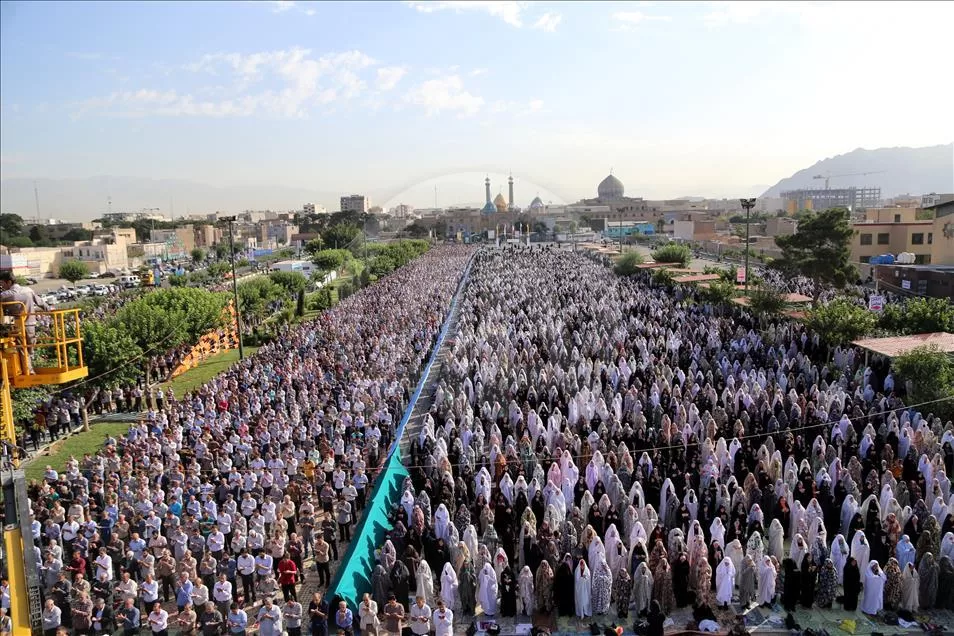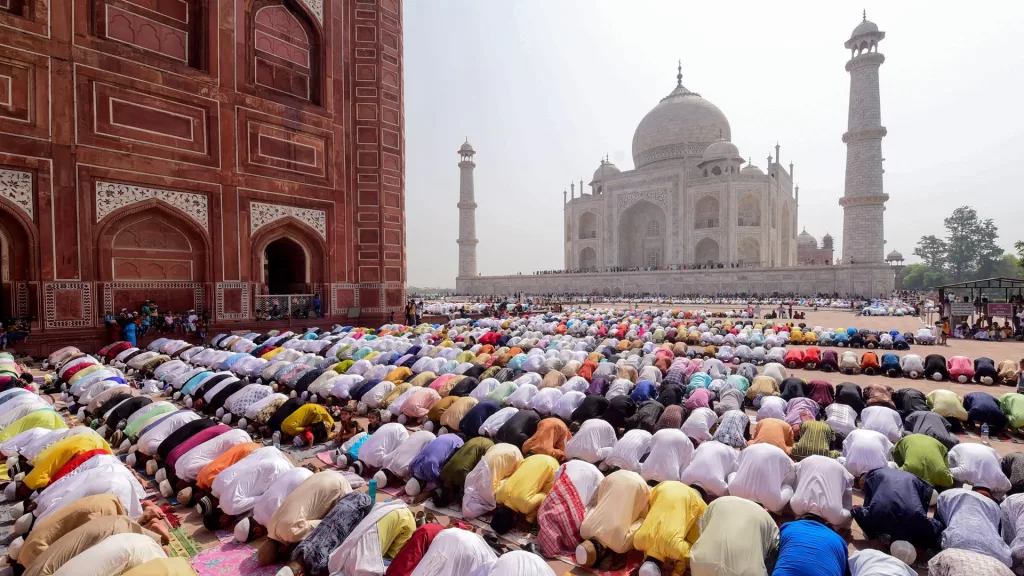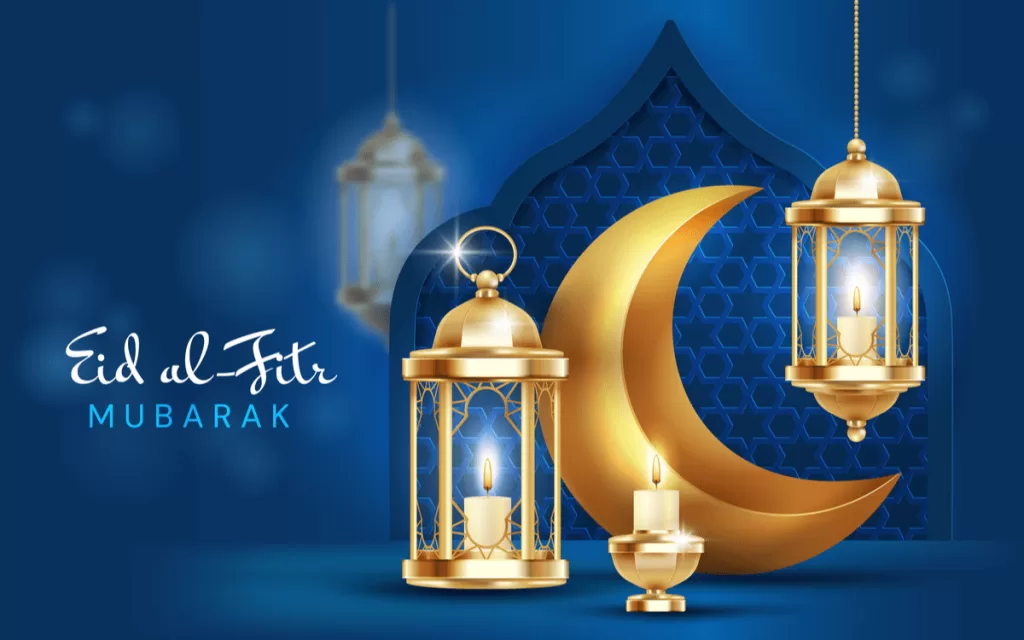Eid al-Fitr is one of the most important and joyous occasions for Muslims around the world. It marks the end of Ramadan, the holy month of fasting, and celebrates the completion of a spiritual journey of worship, charity and self-discipline. In this blog post, we will explore what Eid al-Fitr is, when it is celebrated, how it is celebrated and how different countries and regions observe this Muslim festival.
5 Interesting Facts About Eid Al-Fitr:
- Eid Al-Fitr means “festival of breaking the fast” in Arabic.
- The first Eid Al-Fitr was celebrated in 624 CE by the Prophet Muhammad himself.
- The Eid prayer is traditionally performed outdoors, weather permitting.
- Muslims are required to give to charity during Ramadan and often continue this practice during Eid Al-Fitr.
- Eid Al-Fitr is also known as “Sweet Eid” because of the many sweet treats that are enjoyed during the holiday.
What is Eid al-Fitr?
Meaning and significance of Eid al-Fitr
Eid al-Fitr means “the festival of breaking the fast” in Arabic. It is a time to express gratitude to Allah for the strength and guidance He provided during Ramadan. It is also a time to share the blessings and joy of Eid with family, friends and the less fortunate. Eid al-Fitr is a day of forgiveness, peace and unity among Muslims.
Historical background of Eid al-Fitr
Eid al-Fitr was first celebrated by Prophet Muhammad (peace be upon him) and his companions after their victory over the pagan tribe of Quraish in the Battle of Badr in 624 CE. The Prophet (pbuh) instructed his followers to fast on the last day of Ramadan and then celebrate Eid al-Fitr the next day. Since then, Eid al-Fitr has been observed by Muslims every year following the lunar calendar.

Celebrations around the world
Eid al-Fitr is celebrated by Muslims in every corner of the world with diverse cultural and ethnic backgrounds. While the core religious rituals and practices are common among all Muslims, there are also variations in customs, traditions and festivities depending on the local context. Some of these include wearing new clothes, exchanging gifts, visiting graves, decorating homes and streets, attending carnivals and fairs, watching fireworks and enjoying special cuisines.
When is Eid al-Fitr celebrated?
Calculation of Eid al-Fitr date
Eid al-Fitr is determined by the sighting of the new moon that marks the beginning of the month of Shawwal in the Islamic calendar. Since the Islamic calendar is based on lunar cycles, the date of Eid al-Fitr varies from year to year and from place to place according to the geographical location and time zone. The Islamic calendar has 12 months and each month has either 29 or 30 days depending on the moon phases. Therefore, Eid al-Fitr can fall on any day of the Gregorian calendar.
Moon sighting and its importance
Moon sighting is a religious obligation for Muslims to confirm the start and end of Ramadan and other Islamic months. It involves observing the sky at sunset on the 29th day of Ramadan to look for the crescent moon. If the moon is sighted, then Eid al-Fitr is declared for the next day. If not, then Ramadan is extended for one more day and Eid al-Fitr is celebrated on the following day. Moon sighting is done by qualified scholars and experts who announce their findings to the public through media outlets or official statements.
How is Eid al-Fitr celebrated?
Preparations leading up to Eid al-Fitr
Muslims start preparing for Eid al-Fitr days or even weeks before its arrival. They clean their houses, buy new clothes and accessories, shop for gifts and food items, pay zakat (obligatory charity) and sadaqah (voluntary charity) to help the poor and needy, make plans for visiting relatives and friends, send greetings and invitations to loved ones and perform extra prayers and acts of worship.
Prayer and worship during Eid al-Fitr
On the day of Eid al-Fitr, Muslims wake up early in the morning, take a bath, wear their best clothes, apply perfume and eat something sweet before heading to the mosque or an open field for performing the Eid prayer. The Eid prayer consists of two units (rakat) followed by a sermon (khutbah) delivered by an imam (leader). The prayer is usually held shortly after sunrise but can be delayed until noon depending on local circumstances. After the prayer, Muslims greet each other with hugs and kisses and say “Eid Mubarak” which means “Blessed Eid”.
Festivities and traditions during Eid al-Fitr
The rest of the day is spent in enjoying various festivities and traditions that vary from region to region. Some common ones include:
- Visiting relatives and friends: Muslims visit their relatives and friends to exchange greetings, gifts and blessings. They also seek forgiveness from each other for any mistakes or misunderstandings that may have occurred during the year.
- Giving money to children: Muslims give money or presents to children as a token of love and appreciation. This is also a way of teaching them generosity and gratitude.
- Eating food and sweets: Muslims feast on various
Food and sweets associated with Eid al-Fitr
Eid al-Fitr is also a time to indulge in delicious food and sweets, which are often prepared in advance or bought from special markets. Some of the most popular dishes that are served on Eid al-Fitr are:
- Biryani: a rice dish with meat, vegetables, spices, and nuts.
- Kebab: grilled or roasted meat on skewers or flatbread.
- Samosa: fried pastry filled with meat, cheese, potatoes, or vegetables.
- Haleem: a stew made of wheat, barley, lentils, meat, and spices.
- Harira: a soup made of chickpeas, lentils, tomatoes, meat, and herbs.
Some of the most popular sweets that are enjoyed on Eid al-Fitr are:
- Baklava: a pastry made of layers of filo dough filled with nuts and honey.
- Sheer khurma: a pudding made of vermicelli, milk, dates, nuts, and saffron.
- Maamoul: a cookie made of semolina dough filled with dates, nuts, or pistachios.
- Halwa: a confection made of flour, butter, sugar, nuts, and cardamom.
- Kunafa: a pastry made of shredded wheat dough filled with cheese or cream and soaked in syrup.
Eid al-Fitr around the world
Eid al-Fitr is celebrated by millions of Muslims in different countries and regions around the world. Each place has its own way of observing this festival, depending on its culture, history, and traditions. Here are some examples of how Eid al-Fitr is celebrated in different parts of the world:
How different countries celebrate Eid al-Fitr
Eid al-Fitr is a global celebration that reflects the diversity and richness of Muslim culture. Here are some examples of how different countries celebrate Eid al-Fitr:
- Indonesia: Indonesia is the largest Muslim country in the world with over 200 million Muslims. Eid al-Fitr is known as Lebaran or Idul Fitri in Indonesia. It is a national holiday that lasts for two days. Indonesians celebrate Eid al-Fitr by visiting their ancestral homes (mudik), performing communal prayers (shalat Id), asking for forgiveness (maaf lahir dan batin), giving money to children (angpao), and enjoying special dishes such as ketupat (rice cakes), opor ayam (chicken curry), rendang (spicy beef), and dodol (sticky rice cake).
- Turkey: Turkey is a secular country with a majority Muslim population. Eid al-Fitr is known as Ramazan Bayramı or Şeker Bayramı in Turkey. It is a three-day holiday that starts with a cannon fire at dawn. Turks celebrate Eid al-Fitr by attending prayers at mosques or public squares, visiting graves of loved ones (ziyaret), giving candy to children (şeker), and hosting family feasts with dishes such as börek (savory pastry), dolma (stuffed vegetables), baklava (sweet pastry), and lokum (Turkish delight).
- Nigeria: Nigeria is a multi-religious country with a large Muslim population. Eid al-Fitr is known as Sallah or Id el Fitr in Nigeria. It is a two-day holiday that coincides with the end of the rainy season. Nigerians celebrate Eid al-Fitr by dressing in colorful attire, especially women who wear hijabs (headscarves) and kaftans (long robes). They also perform prayers at mosques or open fields, exchange greetings and gifts, slaughter rams or cows (iyalaya), and enjoy delicacies such as jollof rice, suya (grilled meat), kunu (millet drink), and chin chin (fried dough).

Unique traditions and customs of Eid al-Fitr in different regions
One of the common practices of Eid al-Fitr is to wear new or clean clothes, preferably in white or bright colors, to symbolize purity and joy. However, some regions have their own distinctive styles and outfits for Eid al-Fitr. For example, in Indonesia, the largest Muslim country in the world, women wear colorful kebaya (a traditional blouse) and batik (a dyed fabric) skirts or dresses, while men wear sarong (a long cloth wrapped around the waist) and peci (a black cap). In Morocco, women wear kaftan (a long robe) and takchita (a two-piece dress) in various colors and patterns, adorned with jewelry and henna tattoos. In Pakistan, women wear shalwar kameez (a loose tunic and trousers) and dupatta (a long scarf), while men wear kurta (a long shirt) and shalwar or pajama (loose trousers).
Another common practice of Eid al-Fitr is to visit the mosque for the Eid prayer, which is usually held in the morning after sunrise. However, some regions have their own unique ways of performing the prayer. For example, in China, where Muslims are a minority group, they often gather in public squares or parks for the prayer, as there are not enough mosques to accommodate them. In Turkey, where Islam is the dominant religion, they often hold the prayer in large stadiums or arenas, where thousands of people can join together. In Iran, where Shia Islam is the main sect, they often add an extra prayer called namaz-e-javaherat (the prayer of jewels), which is recited after the regular Eid prayer.
Major Eid al-Fitr events and festivals around the world
Eid al-Fitr is celebrated in different ways across the Muslim world, reflecting the diversity and richness of Islamic culture. Here are some of the major events and festivals that take place during this occasion:
- In Turkey, Eid al-Fitr is known as Şeker Bayramı or “Sugar Feast”, as people offer sweets to their guests and children. The Turkish government also organizes public concerts, shows and fireworks to mark the festival.
- In Indonesia, Eid al-Fitr is called Lebaran or Idul Fitri, and it is a national holiday that lasts for two days. People visit their relatives and friends, especially in their hometowns or villages, and ask for forgiveness for any mistakes they have made in the past year. They also decorate their homes with lanterns, flowers and banners.
- In Iran, Eid al-Fitr is called Eid-e Fitr or Fetr, and it is a time to honor the martyrs of Islam. People visit the graves of their loved ones and pay tribute to them with flowers and prayers. They also enjoy traditional dishes such as sholeh zard (saffron rice pudding) and reshteh polo (noodle rice). Radtravel Agency offers various tours and packages for those who want to travel to Iran and experience its rich culture and history.
How to prepare for Eid al-Fitr
Eid al-Fitr requires some preparation before the actual day of celebration. Here are some tips on how to get ready for this festival:
- Make sure you have paid your zakat al-fitr or fitrana, which is a compulsory charity that every Muslim must give before Eid al-Fitr. The amount varies depending on your income and location, but it is usually equivalent to one day’s food for a person. You can give it to a local mosque or a charity organization that distributes it to the needy.
- Clean your house thoroughly and decorate it with lights, balloons, flags and other festive items. You can also buy new clothes, accessories and gifts for yourself and your family members.
- Prepare some delicious food for Eid al-Fitr, such as dates, fruits, nuts, cakes, cookies and other sweets. You can also cook some special dishes that are typical of your region or country. For example, you can make biryani (rice with meat), korma (curry), samosas (fried pastries) or kebabs (grilled meat) if you are from South Asia or Middle East.
- Plan your activities for Eid al-Fitr, such as visiting your relatives and friends, going to the mosque for prayers, attending cultural events or festivals, or taking a trip to a nearby place. You can also volunteer for a social cause or donate to a charity that supports a good cause.

15 FAQs and Answers:
- What is Eid Al-Fitr?
Eid Al-Fitr is a Muslim festival that marks the end of Ramadan, the holy month of fasting. - When is Eid Al-Fitr celebrated?
Eid Al-Fitr is celebrated on the first day of Shawwal, the tenth month of the Islamic calendar. - What are the traditions associated with Eid Al-Fitr?
Eid Al-Fitr is a time for Muslims to gather with family and friends, exchange gifts, enjoy festive meals, and give to charity. - How do people prepare for Eid Al-Fitr?
In the days leading up to Eid Al-Fitr, Muslims often clean their homes, buy new clothes, and decorate their houses with lights and ornaments. - What is the significance of Eid Al-Fitr?
Eid Al-Fitr is a time to express gratitude for the blessings of Ramadan and to celebrate the renewal of faith and commitment to God. - What types of food are typically eaten during Eid Al-Fitr?
Traditional Eid Al-Fitr dishes vary by region, but commonly include sweet treats like baklava, dates, and other pastries. - Can non-Muslims participate in Eid Al-Fitr celebrations?
Yes, non-Muslims are welcome to join in on Eid Al-Fitr celebrations and learn about Islamic culture and traditions. - How long do Eid Al-Fitr celebrations last?
Eid Al-Fitr celebrations typically last for three days, but can vary depending on cultural norms and regional customs. - What is the Eid prayer?
The Eid prayer is a special congregational prayer that Muslims perform on the morning of Eid Al-Fitr. - Are there any restrictions during Eid Al-Fitr?
During Eid Al-Fitr, Muslims are not allowed to fast and are encouraged to indulge in festive foods and drinks. - How does Eid Al-Fitr differ from Eid al-Adha?
Eid Al-Fitr marks the end of Ramadan, while Eid al-Adha celebrates the willingness of Ibrahim (Abraham) to sacrifice his son as an act of obedience to God. - What is the significance of the moon sighting for Eid Al-Fitr?
The sighting of the new moon determines the start of Eid Al-Fitr and is considered an important event in the Islamic calendar. - How do children celebrate Eid Al-Fitr?
Children often receive gifts and money from their elders during Eid Al-Fitr, and participate in fun activities like face painting and games. - Do all countries celebrate Eid Al-Fitr?
Eid Al-Fitr is primarily celebrated in Muslim-majority countries, but is also observed in many other parts of the world. - How can I learn more about Eid Al-Fitr?
You can learn more about Eid Al-Fitr by attending local community events, visiting Islamic cultural centers, or reading books and articles about the holiday.

